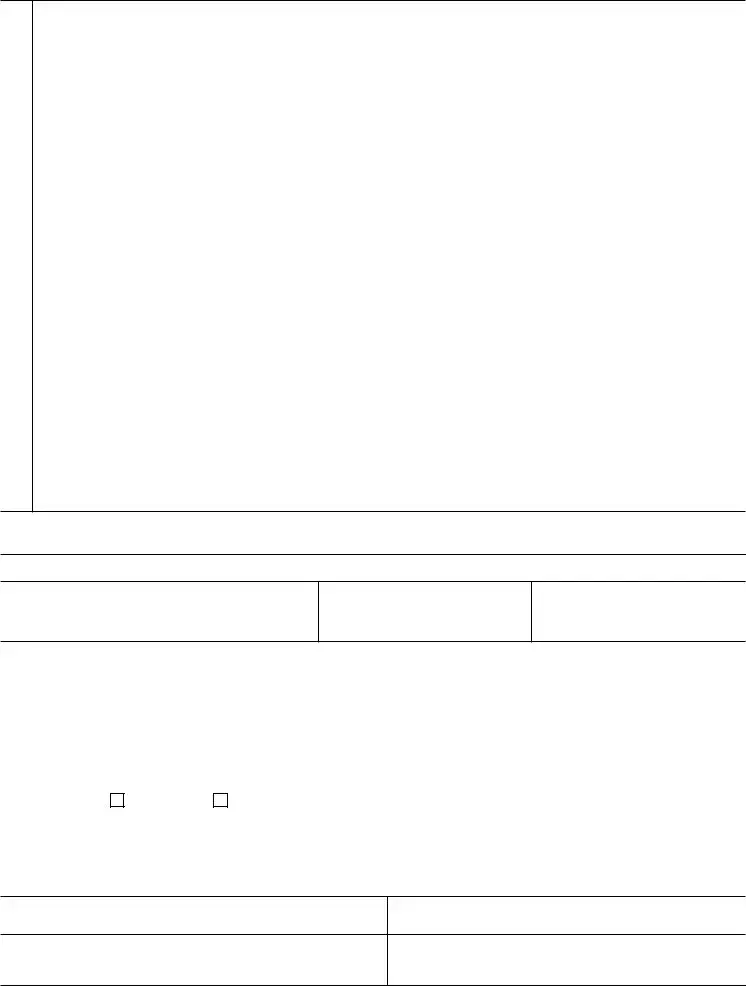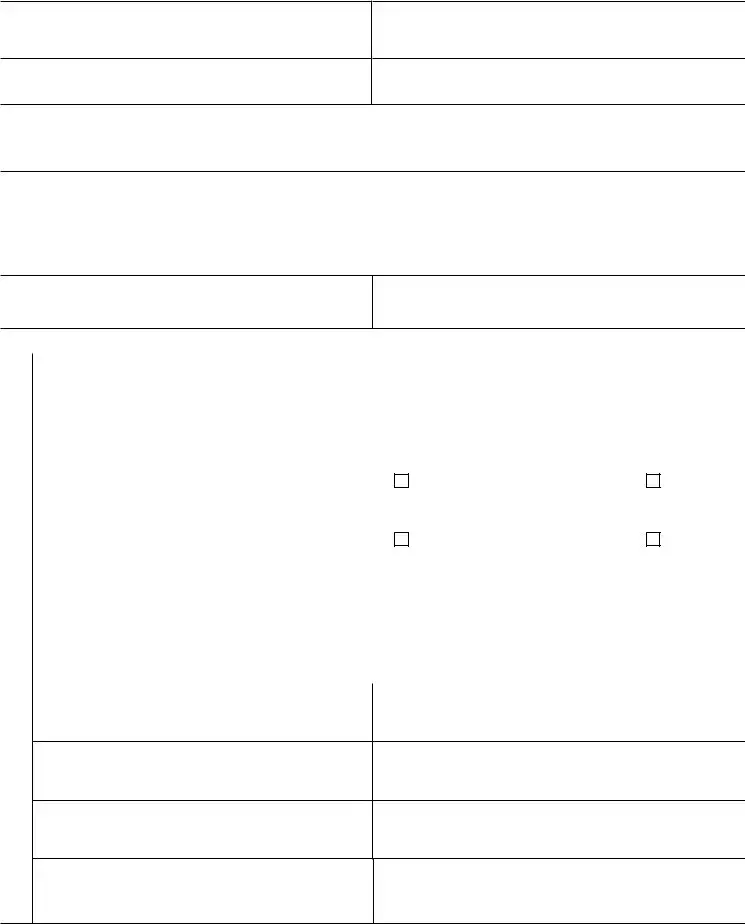|
Form Approved |
Social Security Administration |
OMB No. 0960-0101 |
|
|
CLAIM FOR AMOUNTS DUE IN THE CASE OF A DECEASED BENEFICIARY
PRINT NAME OF DECEASED
If the deceased received benefits on another person's record, print name of that worker
SOCIAL SECURITY NUMBER OF DECEASED
NAME OF THE WORKER
The deceased may have been due a Social Security payment and/or a Medicare Premium refund. The Social Security Act provides that amounts due a deceased may be paid to the next of kin or the legal representative of the estate under priorities established in the law. To help us decide who should receive any payment due, please COMPLETE THIS ENTIRE FORM and RETURN it to us in the enclosed envelope.
This claim for the amounts due is being made on behalf of the family or the estate of |
|
_________________________ who died on ______________ day of ________________ |
_________________ |
(name of deceased) |
(month) |
(year) |
and who lived in the state of _________________________ .
RELATIONSHIP TO DECEASED (Widow, Son, Legal Representative, etc.)
THE FOLLOWING ARE THE NEXT OF KIN OR LEGAL REPRESENTATIVE OF THE DECEASED NAMED ABOVE:
1. |
NAME OF SURVIVING WIDOW(ER) |
ADDRESS OF SURVIVING WIDOW(ER) (Please print house number, |
|
(Please print. If none, state "NONE") |
street, apt. number, P.O. Box, rural route, city, state, and ZIP code) |
|
|
|
|
|
|
|
|
|
|
ENTER SOCIAL SECURITY NUMBER(S) OF WIDOW(ER) |
|
|
|
|
NAMED ABOVE. |
|
|
|
|
|
|
|
|
|
WAS THE WIDOW(ER) NAMED ABOVE LIVING IN THE |
YES |
If "YES", then |
NO |
|
SAME HOUSEHOLD WITH THE DECEASED AT THE TIME |
|
SKIP items 2,3,4,5 and |
|
|
OF DEATH? |
|
SIGN at bottom of page 2. |
|
|
|
|
|
|
WAS HE OR SHE ENTITLED TO A MONTHLY BENEFIT |
YES |
If "YES", then |
NO |
|
|
|
|
|
ON THE SAME EARNINGS RECORD AS THE DECEASED |
|
SKIP items 2,3,4,5 and |
(Go on to item 2) |
|
AT THE TIME OF DEATH? |
|
SIGN at bottom of page 2. |
|
|
|
|
|
|
|
|
|
2. |
ENTER NUMBER OF LIVING CHILDREN OF THE DECEASED. INCLUDE ADOPTED CHILDREN AND |
NUMBER |
|
STEPCHILDREN; INCLUDE GRANDCHILDREN AND STEP-GRANDCHILDREN IF THEIR PARENTS ARE |
|
|
DISABLED OR DECEASED; OR IF THEY HAVE BEEN ADOPTED BY THE SURVIVING SPOUSE OF THE |
|
|
DECEASED. IF NONE OF THE ABOVE, SHOW "NONE" AND GO ON TO ITEM 4. |
|
|
|
|
|
|
PRINT NAME AND COMPLETE ADDRESS OF EACH CHILD |
|
|
Remarks -(If you need more space for explaining any answers to the questions, attach a separate sheet.) |
|
|
|
|
NAME OF CHILD |
ADDRESS OF CHILD (Include house number, street, apt. number, |
|
|
P.O. Box, rural route, city, state, and ZIP code) |
|
RELATIONSHIP TO DECEASED (Grandchild, stepchild, etc.)
SOCIAL SECURITY NUMBER OF CHILD
ADDRESS OF CHILD (Include house number, street, apt. number, P.O. Box, rural route, city, state, and ZIP code)
RELATIONSHIP TO DECEASED (Grandchild, stepchild, etc.)
SOCIAL SECURITY NUMBER OF CHILD
Form SSA-1724-F4 (05-2016) Use Prior Editions |
Page 1 |

3.If any child listed in item 2 has a different name from that given at birth, attach a separate sheet with the following information: Child's Present Name, Name Given At Birth, and a brief explanation for the difference (e.g. Marriage or Court Order).
4. ENTER NUMBER OF LIVING PARENTS OF THE DECEASED |
|
NUMBER |
|
|
|
(Include adopting parents and stepparents. If none, show "None") IF THERE ARE NO LIVING PARENTS, GO |
|
|
ON TO ITEM 5. |
|
|
|
|
|
|
|
PRINT NAME AND COMPLETE ADDRESS OF EACH PARENT |
|
|
|
|
NAME OF LIVING PARENT |
ADDRESS OF LIVING PARENT (Include house number, street, apt. |
|
|
number, P.O. Box, rural route, city, state, and ZIP code) |
|
|
|
|
|
ENTER SOCIAL SECURITY NUMBER OF PARENT NAMED |
|
|
|
|
|
|
NAME OF LIVING PARENT |
ADDRESS OF LIVING PARENT (Include house number, street, apt. |
|
|
number, P.O. Box, rural route, city, state, and ZIP code) |
|
|
|
|
|
ENTER SOCIAL SECURITY NUMBER OF PARENT NAMED. |
|
|
|
|
|
|
5.LEGAL REPRESENTATIVE OF THE DECEASED'S ESTATE (Skip this item if relatives are listed in 1, 2, or 4.)
NAME OF LEGAL REPRESENTATIVE (Please print) |
ADDRESS OF LEGAL REPRESENTATIVE (Please print house |
|
number, street, apt. number, P.O. Box, rural route, city, state, and |
|
ZIP code.) |
|
|
NOTE: If you are applying as legal representative, please submit a certified copy of your letters of appointment.
I declare under penalty of perjury that I have examined all the information on this form, and on any accompanying statements or forms, and it is true and correct to the best of my knowledge.
SIGNATURE OF APPLICANT
SIGNATURE (First name, middle initial, last name)
TELEPHONE NUMBER (Include area code)
MAILING ADDRESS (House number and street, apt. number, P.O. Box, or rural route)
CITY |
STATE |
NAME OF COUNTY |
ZIP CODE |
|
|
|
|
|
Direct Deposit Payment Address (Financial Institution) |
|
|
|
Type of Account |
Nine Digit Routing Number |
|
|
|
|
Checking |
Savings |
|
|
|
|
|
|
Account Number |
|
|
|
|
|
|
|
WITNESSES ARE REQUIRED ONLY IF THIS APPLICATION HAS BEEN SIGNED BY MARK (X) ABOVE. IF SIGNED BY MARK (X), TWO WITNESSES TO THE SIGNING WHO KNOW THE APPLICANT MUST SIGN BELOW GIVING THEIR FULL ADDRESSES.
ADDRESS (House number and street, city, state, and ZIP code)
ADDRESS (House number and street, city, state, and ZIP code)
Form SSA-1724-F4 (05-2016) |
Page 2 |
Paperwork Reduction Act Statement
PRIVACY ACT NOTICE
Section 204(d) of the Social Security Act, as amended, authorizes us to collect this information. We will use this information to help us determine the beneficiary’s payment.
Furnishing us the information is voluntary. However, failing to provide us with all or part of the requested information may prevent us from making an accurate and timely decision on your claim, which may result in the loss of payments.
We rarely use the information you supply for any purpose other than for determining problems in Social Security programs. However, we may use it for the administration and integrity of Social Security programs. We may also disclose information to another person or to another agency in accordance with approved routine uses, which include, but are not limited to the following:
1)To contractors and other Federal agencies, as necessary, for the purpose of assisting the Social Security Administration in the efficient administration of its programs;
2)To comply with Federal laws requiring the release of information from Social Security records (e.g., to the Government Accountability Office and Department of Veteran's Affairs);
3)To make determinations for eligibility in similar health and income maintenance programs at the Federal, State, and local level; and,
4)To facilitate statistical research, audit, or investigatory activities necessary to assure the integrity and
improvement of Social Security programs.
We may also use the information you provide in computer matching programs. Matching programs compare our records with records kept by other Federal, State, or local government agencies. We use the information from these matching programs to establish or verify a person's eligibility for federally-funded and administered benefit programs and for repayment, incorrect payments or delinquent debts under these programs.
A complete list of routine uses for this information is available in our Privacy Act Systems of Records Notices, 60-0089, Claims Folder Systems, and 60-0090, Master Beneficiary Record. These notices, additional information regarding our programs and systems, are available on-line at www.socialsecurity.gov or at any local Social Security office.
This information collection meets the requirements of 44 U.S.C. § 3507, as amended by section 2 of the Paperwork Reduction Act of 1995. You do not need to answer these questions unless we display a valid Office of Management and Budget (OMB) control number. We estimate that it will take about 10 minutes to read the instructions, gather the facts, and answer the questions. Send only comments relating to our time estimate above to: SSA, 6401 Security Blvd, Baltimore, MD 21235-6401.
Form SSA-1724-F4 (05-2016) |
Page 3 |



